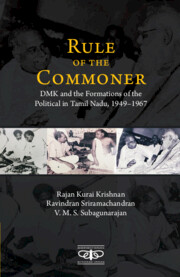12 - Eruption 217
Published online by Cambridge University Press: 15 June 2022
Summary
On the day the Dravida Munnetra Kazhagam (DMK) wasfounded, September 17, 1949, the debates on theDraft Constitution of India were being held in theConstituent Assembly. They were concluded in amonth's time; the draft was approved by November 14,1949, and was formally adopted on January 24, 1950,four months from the day the DMK was founded. Itcould be said that the Republic of India and the DMKwere born simultaneously. The information issignificant because the party mirrored and shared anantinomy of the new republic. The DMK vowed to workfor another republic, the south Indian federation ofstates known as Dravida Nadu. It decided to work forthe goal under the conditions of possibility madeavailable by the Indian republic, a Union of States.We can thus say that the political mobilization ofthe DMK is constituted by an antinomy. This antinomyimmediately mirrored the antinomy of centrifugal andcentripetal tendencies of power consolidation inIndian polity. As per the Constitution, the term“state” is applied to the regional governments thatconstitute the Union. The “union of states” iscentrally governed. There is a lasting antinomy inthe formation. On the one hand, in effect, thepowers are largely concentrated at the Union, makingthe Union government a unitary state with theprovincial governments, grandiosely called States,increasingly becoming dependent on the centralpower. On the other hand, popular politics,particularly electoral outcomes, have beenstrengthening party formations at the regionallevel, thus constituting the antinomy of therepublic in the practice of popular electoraldemocracy.
The DMK was an exemplar of the autonomous politicalformations at the regional level. It was alsodistinguished by the fact that the very building ofthe party structure involved elections to varioustiers of party positions. The way the party wroteits constitution and conducted organizationalelections pointed to the liberal streak of politicsit endorsed, which aligned it with a possibleelectoral participation.
- Type
- Chapter
- Information
- Rule of the CommonerDMK and Formations of the Political in Tamil Nadu, 1949–1967, pp. 239 - 257Publisher: Cambridge University PressPrint publication year: 2022

